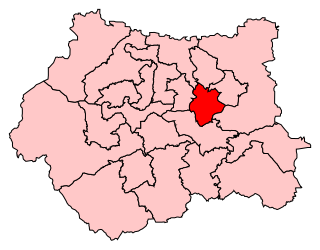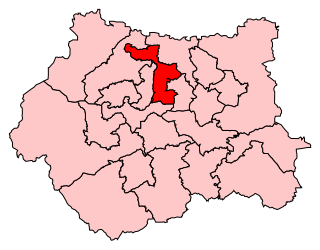Related Research Articles

Leeds Central was a constituency represented in the House of Commons of the UK Parliament. The constituency first existed from 1885 until it was abolished in 1955. It was recreated in 1983.

Leeds North West is a constituency in the City of Leeds which has been represented in the House of Commons of the UK Parliament since 2024 by Katie White, of the Labour Party.

Leeds West was a borough constituency covering the western part of the city of Leeds, West Yorkshire which is represented in the House of Commons of the Parliament of the United Kingdom. It elected one Member of Parliament (MP) by the first-past-the-post system of election. With the exception of the Parliament of 1983–87, the seat was held by Labour since 1945.

Normanton was a county constituency represented in the House of Commons of the Parliament of the United Kingdom. It elected one Member of Parliament (MP) by the first past the post system of election.

Pudsey was a constituency represented in the House of Commons of the UK Parliament.

Leeds East is a constituency represented in the House of Commons of the UK Parliament since 2015 by Richard Burgon of the Labour Party until his suspension and whip withdrawn on 23 July 2024, as a result of voting to scrap the two child benefit cap. He now sits as an Independent MP until the whip is re-established.

Hemsworth was a constituency in West Yorkshire represented in the House of Commons since 1996 by Jon Trickett of the Labour Party.

Rossendale was a parliamentary constituency in the Lancashire, England. Created in 1885, it elected one Member of Parliament (MP) to the House of Commons of the Parliament of the United Kingdom, elected by the first-past-the-post voting system. When created it comprised the districts of Rawtenstall, Bacup, and Haslingden; Ramsbottom district was added to the constituency in 1950.

Leeds South is a parliamentary constituency in the city of Leeds, West Yorkshire, which returns one Member of Parliament (MP) to the House of Commons of the Parliament of the United Kingdom. The constituency existed from 1885 to 1983 and was recreated in 2024 following the 2023 Periodic Review of Westminster constituencies.

Skipton was a county constituency centred on the town of Skipton in Yorkshire which returned one Member of Parliament (MP) to the House of Commons of the Parliament of the United Kingdom.

Cleveland was a county constituency in the Langbaurgh Wapentake, North Riding of Yorkshire, England.
Elland was a parliamentary constituency in the West Riding of Yorkshire that existed between 1885 and 1950. It elected one Member of Parliament (MP) to the House of Commons of the United Kingdom, by the first-past-the-post voting system.
Leeds North was a borough constituency in the city of Leeds, West Yorkshire, which returned one Member of Parliament (MP) to the House of Commons of the Parliament of the United Kingdom, elected by the first past the post voting system.

Spen Valley is a parliamentary constituency in the valley of the River Spen in the West Riding of Yorkshire. It returned one Member of Parliament (MP) to the House of Commons of the Parliament of the United Kingdom.
Penrith and Cockermouth was a parliamentary constituency centred on the towns of Penrith and Cockermouth in Cumberland, England. It was alternatively known as Mid Cumberland. It returned one Member of Parliament (MP) to the House of Commons of the Parliament of the United Kingdom, elected by the first past the post system.
Otley was a parliamentary constituency between 1885 and 1918 centred on the town of Otley, then in the West Riding of Yorkshire and now in West Yorkshire. It returned one Member of Parliament (MP) to the House of Commons of the Parliament of the United Kingdom, elected by the first past the post system.
Rothwell was a parliamentary constituency centred on the Rothwell area of West Yorkshire. It returned one Member of Parliament (MP) to the House of Commons of the Parliament of the United Kingdom, elected by the first past the post system.
Hanley was a borough constituency in Staffordshire which returned one Member of Parliament (MP) to the House of Commons of the Parliament of the United Kingdom between 1885 and 1950. Elections were held using the first past the post voting system.
Arthur Rhys Barrand was a British Liberal Party politician.
Lt-Col. John Christopher Smuts OBE BCL, known as Christopher Smuts was a South African born British barrister and Liberal Party politician.
References
- ↑ Wharfedale & Airedale Observer, 3 January 1919
- 1 2 3 4 5 6 British Parliamentary Election Results 1918-1949, FWS Craig
- ↑ The Yorkshire Post and Leeds Intelligencer, 2 May 1938
- ↑ "Parliamentary candidates' protest", The Times , 6 April 1939
- ↑ Report of the Annual Conference of the Labour Party, 1939
- ↑ "Politics Science Resources".